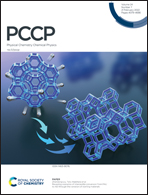Janus Ga2SeTe/In2SSe heterostructures: tunable electronic, optical, and photocatalytic properties†
Abstract
Vertically stacking two-dimensional materials into van der Waals (vdW) heterostructures (HS) is deemed to be an effective strategy to tailor their physical properties and enrich their applications in modern nanoelectronics. Here, we study the geometry, electronic, and optical properties of Janus Ga2SeTe/In2SSe heterostructures by using first-principles calculations. We consider four models of Ga2SeTe/In2SSe heterostructures with an alternative chalcogen atom layer sequence and five potential stacking configurations, and find that the most energy favorable stacking pattern is AB stacking for each model. The heterostructures form type II alignment with a direct band gap. Moreover, the band gap values are highly dependent on the magnitude of the electric dipole, which is related to the sublayer intrinsic dipole direction and interface charge transfer. Additionally, the optical absorption of the heterostructures is intensified in the visible and ultraviolet regime. Furthermore, we predict two heterostructures with the band edge straddling the water redox potential level. These findings can help in understanding the tailored properties of the heterostructures based on Janus two-dimensional materials, and guide experiments in designing novel optoelectronic devices.



 Please wait while we load your content...
Please wait while we load your content...